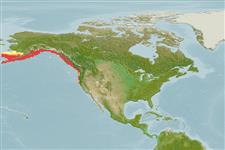Preferred temperature (Ref.
115969): 1.3 - 8.6, mean 4.2 (based on 403 cells).
Phylogenetic diversity index (Ref.
82804): PD
50 = 1.0000 [Uniqueness, from 0.5 = low to 2.0 = high].
Bayesian length-weight: a=0.00372 (0.00182 - 0.00758), b=3.17 (2.99 - 3.35), in cm Total Length, based on LWR estimates for this (Sub)family-body shape (Ref.
93245).
Trophic level (Ref.
69278): 3.3 ±0.37 se; based on food items.
Widerstandsfähigkeit (Ref.
120179): mittel, Verdopplung der Population dauert 1,4 - 4,4 Jahre. (tm=2-6; tmax=5; K=0.34; Fec=17,000-60,000 Musick et al. 2000 (Ref.
36717)).
Prior r = 0.15, 95% CL = 0.10 - 0.22, Based on 1 full stock assessment.
Fishing Vulnerability (Ref.
59153): Low to moderate vulnerability (33 of 100).
Climate Vulnerability (Ref.
125649): Moderate vulnerability (35 of 100).
